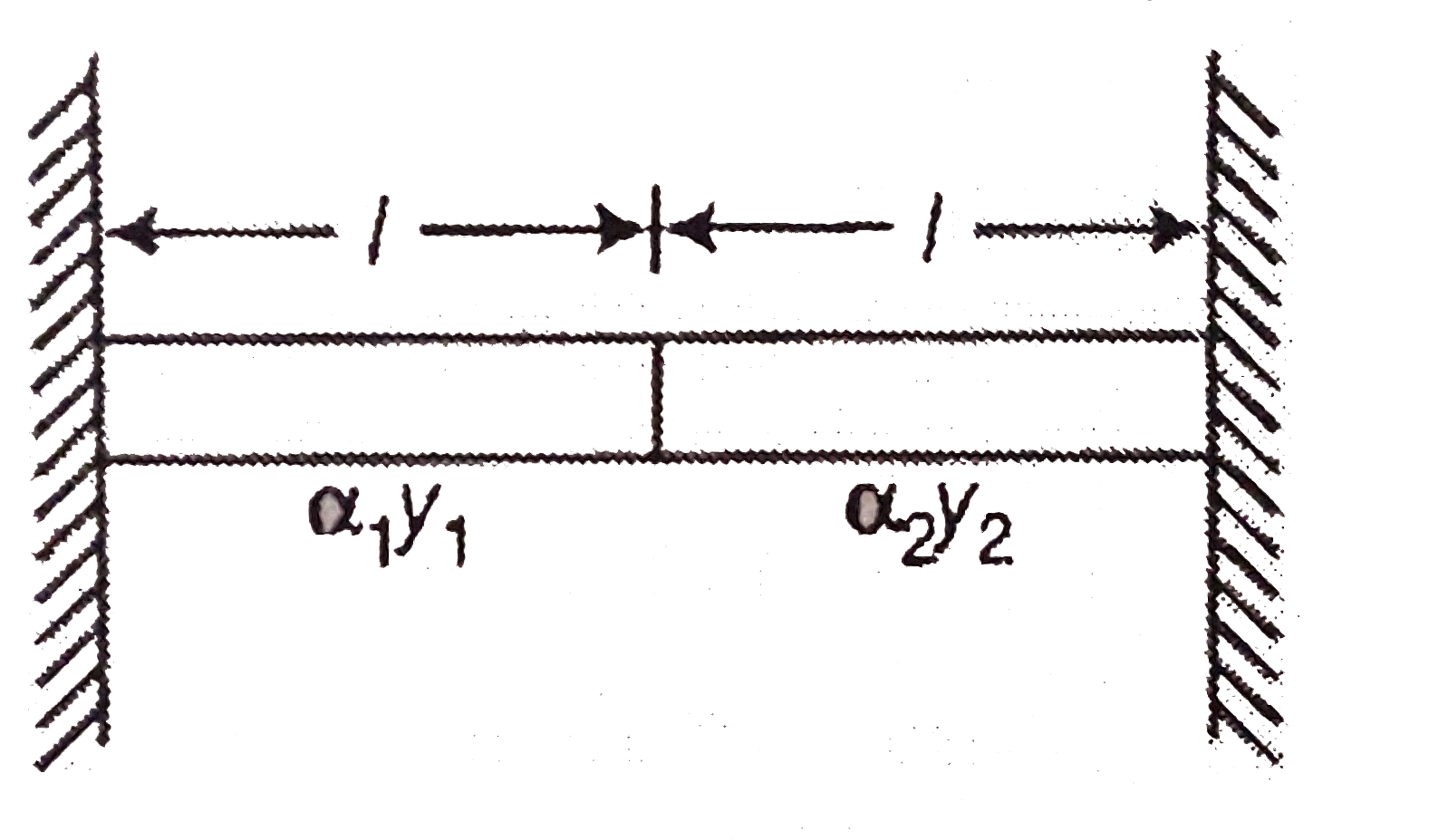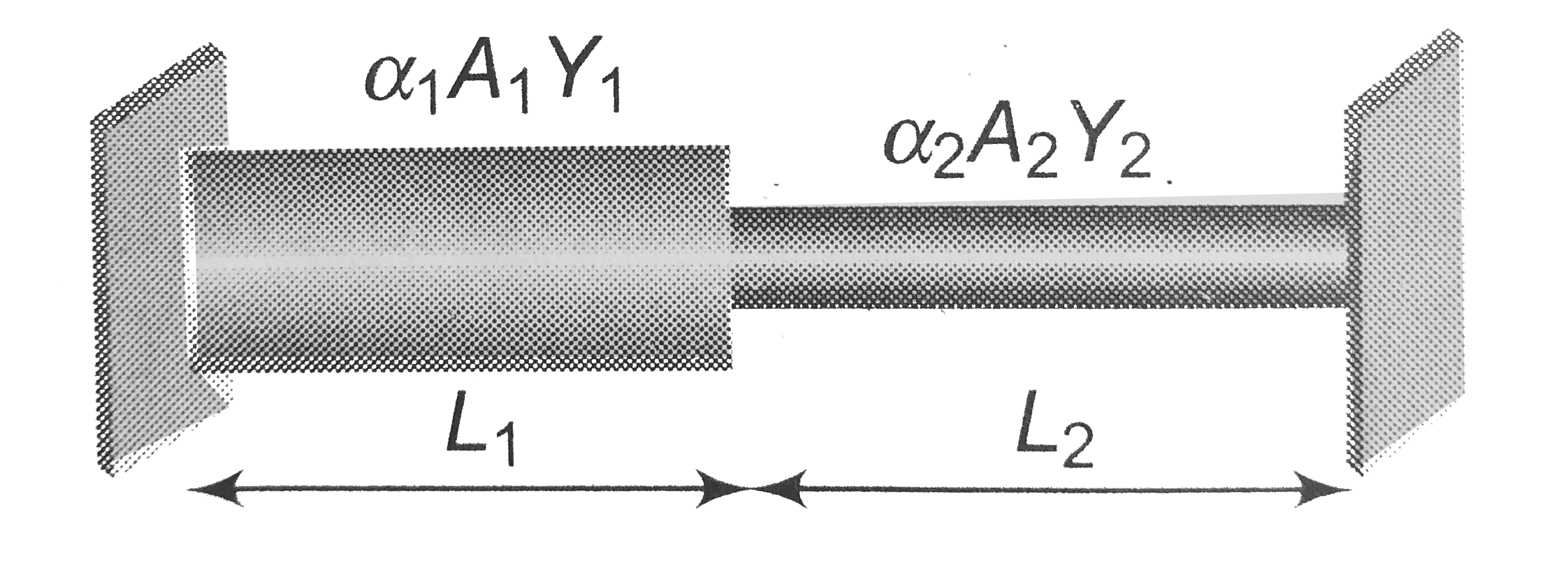Two metal rods are fixed end to end between two rigid supports as shown in figure. Each rod is of length l and area of cross-section is A. When the systeam is heated up,datermine the condition when the juncation between rods does not shift ? (Y1 and Y2 are Young's modulus of materials of rods, α1 and α2 are coefficients of linear expansion)
_S01_022_Q01.png)
Since, each rod is prevented from expension so, they are under compression and mechanical strain. The strain in each rod in zero.
e1l=α1ΔT−FAY1,e2l=αΔT−FAY2,e1l=e2l=0
α1ΔT−FAY1=0 and α2ΔT−FAY2=0
α1ΔT=FAY1..........(1) and α2ΔT=FAY2.......(2)
Dividing (1) by (2), we get α1Y1=α2Y2
Topper's Solved these Questions
- THERMAL PROPERTIES OF MATTERBOOK - NARAYNACHAPTER - THERMAL PROPERTIES OF MATTEREXERCISE - LEVEL-III
22 Videos
- THERMAL PROPERTIES OF MATTERBOOK - NARAYNACHAPTER - THERMAL PROPERTIES OF MATTEREXERCISE - LEVEL-I (C.W.)
23 Videos
- THERMAL PROPERTIES OF MATTERBOOK - NARAYNACHAPTER - THERMAL PROPERTIES OF MATTEREXERCISE - LEVEL-I(H.W.)
21 Videos
- SYSTEM OF PARTICLES AND ROTATIONAL MOTION BOOK - NARAYNACHAPTER - SYSTEM OF PARTICLES AND ROTATIONAL MOTION EXERCISE - EXERCISE - IV
39 Videos
- THERMODYNAMICSBOOK - NARAYNACHAPTER - THERMODYNAMICSEXERCISE - Exercise
187 Videos
Similar Questions
Two rods having length l1 and l2, made of materials with the linear coefficient of expansion α1 and α2 were welded togther. The equivalent coefficients of linear expansion for the obtained rod:-

View SolutionTwo rods of lengths L1 and L2 are welded together to make a composite rod of length (L1+L2). If the coefficient of linear expansion of the materials of the rod are α1 and α2 respectively. The effective coefficient of linear expansion of the composite rod is
View Solution
Knowledge Check
Two metal rods are fixed end to end between two rigid supports, as shown in figure. Each rod is of length 'l' and area of cross-section is A. When the system is heated up, determine the conditioin whenthe juction between rods does not shift.
[Given, Y1 and Y2 are Young's modulus of materials of the rods, α1 and α2 are coefficient at linear expansion.
 A(α1Y2Bα1Y1=α2Y2Cα1=α2DY1=Y2
A(α1Y2Bα1Y1=α2Y2Cα1=α2DY1=Y2Two metal rods are fixed end to end between two rigid supports, as shown in figure. Each rod is of length l and area of cross-section is A. When the system is heated up, determine the condition that the junction between rode not shift. [Given Y1andY2 are Young's modulus of materials of teh rods while α1andα2 are coefficient of linear expansion]
 Aα1Y2=α2Y1Bα1Y1=α2Y2Cα1=α2DY1=Y2
Aα1Y2=α2Y1Bα1Y1=α2Y2Cα1=α2DY1=Y2Two metal rods of the same length and area of cross-section are fixed end to end between rigid supports. The materials of the rods have Young module Y1 and Y2 , and coefficient of linear expansion α1 and α2 . The junction between the rod does not shift and the rods are cooled
AY1α1=Y2α1BY1α2=Y2α1CY1α21=Y2α22DY21α1=Y22α2
Two rods having length l1andl2 made of materials with the linear expansion coefficient α1andα2 were soldered together. The equivalent coefficients of linear expansion for the obtained rod
View SolutionTwo rods are joined between fixed supports as shown in the figure. Condition for no change in the length of individual rods with the increase of temperature will be
(α1,α2= linear expansion coefficient
A1,A2= Area of rods
Y1,Y2= Young modulus )

View SolutionA uniform rod of length (L) and area of cross-section (A) is subjected to tensil load (F). If σ be the Poisson's ratio and Y be the Young's modulus of the material of the rod, then find the volumetric strain produced in the rod.
View SolutionA thin rod of negligible mass and area of cross section S is suspended vertically from one end. Length of the rod is L0 at T∘C . A mass m is attached to the lower end of the rod so that when temperature of the rod is reduced to 0∘C its length remains L0 Y is the Young’s modulus of the rod and α is coefficient of linear expansion of rod. Value of m is :
View SolutionTwo rods AB and BC of equal cross-sectional area are joined together and clamped between two fixed supports as shown in the figure. For the rod AB and road BC lengths are l1 and l2 coefficient of linear expansion are α1 and α2, young's modulus are Y1 and Y2, densities are ρ1 and ρ2 respectively. Now the temperature of the compound rod is increased by θ. Assume of that there is no significant change in the lengths of rod due to heating. then the time taken by transverse wave pulse to travel from end A to other end C of the compound rod is directly proportional to
_E01_086_Q01.png)
View Solution